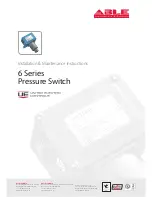
A heartbeat failure triggers the switch to:
• Remove users anchored to the SAC.
• Fail over to the s-SAC (Example: s-SAC now becomes the new SAC).
What happens when the keepalive to a UAC fails?
The users anchored to the UAC are removed and a message is logged to the same effect in the event log.
Why should jumbo frames be enabled at the switch?
Jumbo frames have to be enabled at the controller uplink VLAN as well as the client VLAN. The GRE tunnel adds
an effective 46 bytes to every user packet. The effective tunnel MTU = uplink VLAN MTU -46 bytes for a 1500
MTU, the tunnel MTU gets to be 1454 bytes. This means that a user can send up to only 1,454 bytes of frames.
For users to send up to 1500 (default) MTU, jumbo frames need to be enabled.
What happens when a UAC controller goes down?
A node list update is sent by the SAC to the switch to inform that a controller went down. All users anchored to
that controller are removed (unbootstrapped). After some time, the controller sends a bucket map update to the
switch. The switch then processes the bucket map update and anchors users to the respective controller
(standby) as per the bucket map. The users will then be switched over to s-UAC. The s-UAC becomes the new
UAC, and is assigned after the bucket map update from SAC.
NOTE:
It is important to verify that the bucket map on switch and controller is the same. Also, it
should be verified that users are anchored to the right controller identified in the bucket map on both
the switch and controller.
What happens when a SAC controller goes down?
A node list update is sent by s-SAC to switch. Since the node list is received from the s-SAC and not the SAC, the
switch considers that SAC is down and initiates a failover to s-SAC. Also, the switch removes all users anchored
to SAC. Once s-SAC acknowledges the failover request, the s-SAC becomes the new active SAC. The new
Active SAC then sends a node list update and bucket map update. In the node list update, the new s-SAC will be
provided. The switch will then bootstrap and initiate a heartbeat with new s-SAC. The switch then processes the
bucket map update and anchors users to respective controllers.
NOTE:
It is important to verify that the bucket map on switch and controller is the same. Also, it
should be verified that users are anchored to the right controller identified in the bucket map on both
the switch and controller.
What happens when the s-SAC controller goes down?
A node list update is sent by the SAC to the switch. The switch stops the heartbeat with the s-SAC which has
gone down and removes all users anchored to it. The switch then initiates a bootstrap to a new s-SAC provided in
the node list update. Once a bootstrap acknowledgment is received, the switch starts a heartbeat to the new s-
SAC. After some time, the SAC will send a bucket map update. The switch then processes the update and
anchors users to their respective controllers.
NOTE:
It is important to verify that the bucket map on the switch and controller is the same. Also, it
should be verified that users are anchored to the appropriate controller according to the bucket map
on both the switch and controller.
What do the states in show tunneled-node-server state mean?
• Registering - Bootstrapping
• Registered - Bootstrapped
• Unregistering – Unbootstrapping
What happens when user-role attributes change?
Chapter 18 Dynamic Segmentation
641
















































